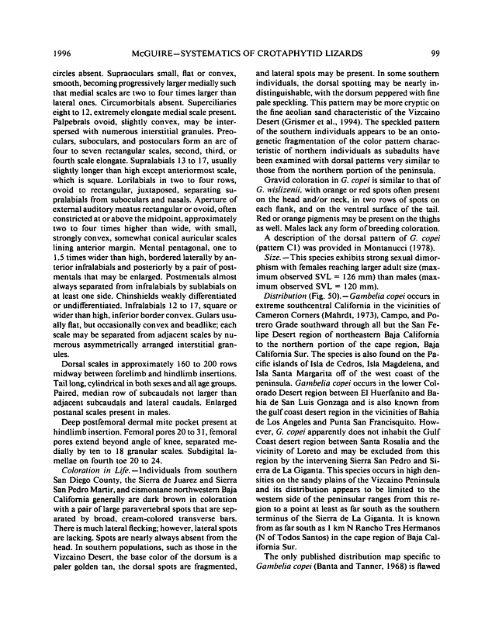Download Full Document - Mountain Boomer Music!
Download Full Document - Mountain Boomer Music!
Download Full Document - Mountain Boomer Music!
You also want an ePaper? Increase the reach of your titles
YUMPU automatically turns print PDFs into web optimized ePapers that Google loves.
McGUIRE- SYSTEMATICS OF CROTAPHYTID LIZARDS<br />
circles absent. Supraoculars small, flat or convex,<br />
smooth, becoming progressively larger medially such<br />
that medial scales are two to four times larger than<br />
lateral ones. Circumorbitals absent. Superciliaries<br />
eight to 12, extremely elongate medial scale present.<br />
Palpebrals ovoid, slightly convex, may be inter-<br />
spersed with numerous interstitial granules. Preo-<br />
culars, suboculars, and postoculars form an arc of<br />
four to seven rectangular scales, second, third, or<br />
fourth scale elongate. Supralabials 13 to 17, usually<br />
slightly longer than high except anteriormost scale,<br />
which is square. Lorilabials in two to four rows,<br />
ovoid to rectangular, juxtaposed, separating su-<br />
pralabials from suboculars and nasals. Aperture of<br />
external auditory meatus rectangular or ovoid, often<br />
constricted at or above the midpoint, approximately<br />
two to four times higher than wide, with small,<br />
strongly convex, somewhal conical auricular scales<br />
lining anterior margin. Mental pentagonal, one to<br />
1.5 times wider than high, bordered laterally by an-<br />
terior infralabials and posteriorly by a pair of post-<br />
mentals that may be enlarged. Postmentals almost<br />
always separated from infralabials by sublabials on<br />
at least one side. Chinshields weakly differentiated<br />
or undifferentiated. Infralabials 12 to 17, square or<br />
wider than high, inferior border convex. Gulan usu-<br />
ally flat, but occasionally convex and beadlike; each<br />
scale may be separated from adjacent scales by nu-<br />
merous asymmetrically arranged interstitial gran-<br />
ules.<br />
Dorsal scales in approximately 160 to 200 rows<br />
midway between forelimb and hindlimb insertions.<br />
Tail long, cylindrical in both sexes and all age groups.<br />
Paired, median row of subcaudals not larger than<br />
adjacent subcaudals and lateral caudals. Enlarged<br />
postanal scales present in males.<br />
Deep postfemoral dermal mite pocket present at<br />
hindlimb insertion. Femoral pores 20 to 3 1, femoral<br />
pores extend beyond angle of knee, separated me-<br />
dially by ten to 18 granular scales. Subdigital la-<br />
mellae on fourth toe 20 to 24.<br />
Coloration in Life. -Individuals from southern<br />
San Diego County, the Sierra de Juarez and Sierra<br />
San Pedro Martir, and cismontane northwestern Baja<br />
California generally are dark brown in coloration<br />
with a pair of large paravertebral spots that are sep-<br />
arated by broad, cream-colored transverse bars.<br />
There is much lateral flecking; however, lateral spots<br />
are lacking. Spots are nearly always absent from the<br />
head. In southern populations, such as those in the<br />
Vizcaino Desert, the base color of the dorsum is a<br />
paler golden tan, the dorsal spots are fragmented,<br />
and lateral spots may be present. In some southern<br />
individuals, the dorsal spotting may be nearly indistinguishable,<br />
with the dorsum peppered with fine<br />
pale speckling. This pattern may be more cryptic on<br />
the fine aeolian sand characteristic of the Vizcaino<br />
Desert (Grismer et al., 1994). The speckled pattern<br />
of the southern individuals appears to be an ontogenetic<br />
fragmentation of the color pattern characteristic<br />
of northern individuals as subadults have<br />
been examined with dorsal patterns very similar to<br />
those from the northern portion of the peninsula.<br />
Gravid coloration in G. copei is similar to that of<br />
G. bvislizenii, with orange or red spots often present<br />
on the head and/or neck, in two rows of spots on<br />
each flank, and on the ventral surface of the tail.<br />
Red or orange pigments may be present on the thighs<br />
as well. Males lack any form of breeding coloration.<br />
A description of the dorsal pattern of G. copei<br />
(pattern Cl) was provided in Montanucci (1978).<br />
Size. -This species exhibits strong sexual dimorphism<br />
with females reaching larger adult size (maximum<br />
observed SVL = 126 mm) than males (maximum<br />
observed SVL = 120 mm).<br />
Distribution (Fig. 50).- Gambelia copei occurs in<br />
extreme southcentral California in the vicinities of<br />
Cameron Corners (Mahrdt, 1973), Campo, and Potrero<br />
Grade southward through all but the San Felipe<br />
Desert region of northeastern Baja California<br />
to the northern portion of the cape region, Baja<br />
California Sur. The species is also found on the Pacific<br />
islands of Isla de Cedros, Isla Magdelena, and<br />
Isla Santa Margarita off of the west coast of the<br />
peninsula. Gat~tbelia copei occurs in the lower Colorado<br />
Desert region between El Huerfanito and Bahia<br />
de San Luis Gonzaga and is also known from<br />
the gulf coast desert region in the vicinities of Bahia<br />
de Los Angeles and Punta San Francisquito. However,<br />
G. copei apparently does not inhabit the Gulf<br />
Coast desert region between Santa Rosalia and the<br />
vicinity of Loreto and may be excluded from this<br />
region by the intervening Sierra San Pedro and Sierra<br />
de La Giganta. This species occurs in high densities<br />
on the sandy plains of the Vizcaino Peninsula<br />
and its distribution appears to be limited to the<br />
western side of the peninsular ranges from this region<br />
to a point at least as far south as the southern<br />
terminus of the Sierra de La Giganta. It is known<br />
from as far south as I km N Rancho Tres Hermanos<br />
(N of Todos Santos) in the cape region of Baja California<br />
Sur.<br />
The only published distribution map specific to<br />
Ga))tbelia copei (Banta and Tanner, 1968) is flawed


